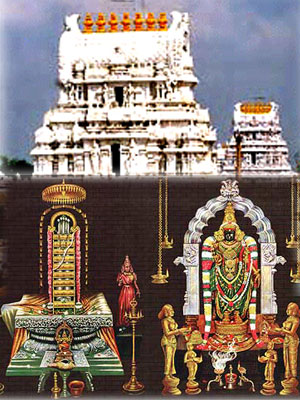|
|
Srikalahasthi Temple

Name of the Temple |
|
Location |
- Near Thirupathi in the state of Āndhra Pradeśh, South India.
- It is located on the banks of the river Swarṇamukhi. It is also informally referred to as Kāḷahasthi.
|
| How to reach there? |
- By Air: Thirupathi Réṅigunṭa Airport is 25 km away. From the airport take the State Highway 61 heading east to reach Śhrī Kālahasthi.
- By Train : Thirupathi Main Railway Station is around 35 km away from Śhrī Kālahasthi. Take the National Highway 71 heading east to reach Śhrī Kālahasthi.
- By Road : Śhrī Kālahasthi is situated 36 km from Thirupathi. The State Highway 61 connects Śhrī Kālahasthi with Thirupathi and the National Highway 16 which is National Highway 16 from Nizāmabādh to Jagdhalpur.
|
Rulers/builders and Time Period
|
- This temple was originally built during Pallava period and current structures are built by Chola Tamil Kings.
- The hill adjacent to temple has still carvings in Pallava style.
- The Cholas renovated the old Pallava temple in 11th century. Kulotthunga Chola I constructed the Gāḷigopuram, the main entrance facing south and Kulotthunga Chola III constructed few other temples.
- In 12th Century A.D., King Vīranarasimha Yādhavarāya built the present Prakāras, and the four Gopurams connecting the four entrances.
- According an inscription of Kriṣhṇadhevarāya of Vijayanagara empire dating back to 1516 A.D., he constructed the Hundred Pillared Manṭapam and the other tall Gāḷigopuram that faces west to east.
- In 1529 A.D., King Achutharāya of the Vijayanagara empire got his coronation performed here, before he celebrated it in his capital city.
|
Deity/Deities |
- Śhrī Kāḷahasthīśhwara and Śhrī Gnyānaprasūnāmbikā Dhevi.
- Śhrī Kāḷahasthīśhwara showers grace to wipe out the sins and obstacles of devotees. Seers and sages worshipped lord Śhrī Kāḷahasthīśhwara and praised him with hymns.
|
Architecture Style |
- Like other great temples, the construction period of Śhrī Kāḷahasthi temple lasted centuries.
- The three lofty Gopurams of the temple are remarkable for their architecture. The 'Rājagopuram' or main gate of the 500-year old. 136-foot ‘Rājagopuram' of the Śhrīkāḷahasthi temple, which has been in a precarious condition due to a deep fissure along its face, collapsed.
- Viśhwakarma Brāhmin Sthapathis who sculpted this temple need to be eulogized for their excellent architectural cognizance.
- This temple features an enormous, ancient gopuram (entrance tower) over the main gate. The tower is 36.5 m (120 ft) high. The entire temple is carved out of the side of a huge stone hill.
- There is a lamp inside the inner sanctum that is constantly flickering despite the lack of air movement inside.
- Air can be observed to move even when the priests close off the entrance to the main deity room, which does not have any windows. One can see the flames on several ghee lamps flicker as if blown by moving air.
- The linga is white and is considered Swayambhu, or self-manifested.
- The vast west facing Kāḷahasthīśhwara temple is built adjoining a hill, and on the banks of the river Swarṇamukhi.
- At some points, the hill serves as the wall of the temple. The temple prakārams follow the contour of the adjoining hill and hence the temple plan is rather irregular.
- North of the temple is the Dhurgāmbika hill, south is the Kaṇṇappar hill and east is the Kumāraswāmi hill.
|
Other Special Features |
- This ancient temple dedicated to Śhiva is one of the Pancha Bhūtha Sthaḷams (temples celebrating Shiva as the embodiment of the primary elements), air being the element in case here, the other five temples being Tiruvaṇṇāmalai (Fire), Chidambaram(Space),Thiruvānaikkāval (Water) and Kānchipuram (Earth) respectively. The name of the place comes from three animals, Śhrī(spider), Kala (snake) and Hasthi (elephant) who worshipped Shiva and gained salvation here.
- A statue that shows all three animals is situated in the main shrine. It is one of the important ancient Śhiva Kṣhethras (Śhiva Temples) of Southern India.
- The Śhrīkāḷahasthi Temple is popularly known as Dakṣhiṇa Kailāsam.
|
Any Other/Remarks |
- The temple is also associated with Rāhu and Kethu (of the nine grahams or celestial bodies in the Indian astrological scheme).
- The river Suvarṇamukhi takes the northerly course at Śhrī Kāḷahasthi almost washing the west wall of the famous temple .
- Inside this very large temple, situated between two steep hills Śhrī puram and Mummidi-cholapuram, is the Śhivalinga set to represent the element of Vāyu.
|
Special References |
- The Skandha Purāṇa, Śhiva Purāṇa and Linga Purāṇas have a mention about Śhrīkāḷahasthi. The Skandha Purāṇa says that Arjuna visited this place, worshipped Kāḷahastīśhwara and met the sage Bhāradhwāja on the top of the hill.
- It is believed that Kaṇṇappa (also known as Bhaktha Kaṇṇappa), a tribal devotee has worshipped Śhiva at Śhrīkāḷahasthi. Śhrī Ādhi Śhankara visited this Kṣhethra and praised the Bhakthi of Kaṇṇappa in his Śhivānandhalahari.
- Tamil saints Nāyanārs like Appar , Sundharar, Sambandhar, Māṇikkavāsagar, Sundharamūrthi, Paṭṭinatthār and Śhrī Rāmalinga Swāmi of Vaḍalur have also visited and praised the deity in their (hymns) thevārams.
- The historical reference to this temple occurs in the works of Nakkīrar, a Tamil poet in 3rd Century BC during the Tamil Sangam Dynasty. He called it as Southern Kailāsa. Nakkīra composed hundred stanzas to praise Śhrī Kāḷahasthīśhwara.
- Dhūrjaṭi, a Thelugu poet and native of this place and one among the Aṣhṭadiggajas of Śhrī Kriṣhṇadevaraya’s court composed hundred stanzas on Śhrī Kāḷahasthīśhwara.
- Other works on this temple include the Śhrī Kāḷatthipurāṇam of the three brothers Karunapprakāsar, Śhivapprakāsar and Velappa Dīkṣhithar, Thiru Kāḷatthipurāṇam by Ānandhakūtthar of Vīrainagar and Thiru Kāḷatthi Ulā by Seraikkavirāyar.
|
Bibliography |
|
|
View Larger Map 



|
|















